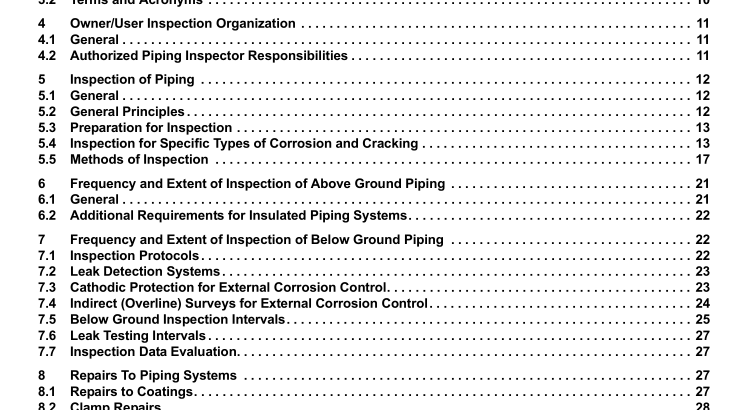API RP 2611:2011 pdf free download.Terminal Piping Inspection— Inspection of In-Service Terminal Piping Systems
4.2.3 Repair Organization
The repair organization shall be responsible to the Owner/User and shall provide the materials, equipment, quality control, and workmanship necessary to maintain and repair the piping systems.
4.2.4 Other Personnel
Operating, maintenance, or other personnel employed by or contracted by the Owner/User who has special knowledge or expertise related to particular piping systems shall be responsible for promptly making the inspector or piping engineer aware of any unusual conditions that may have developed and for providing other assistance, where appropriate.
5 Inspection of Piping
5.1 General Terminal piping inspection can be categorized into inspection for above ground piping and below ground piping. However, there are numerous inspection techniques that are shared between both inspection categories.
5.2 General Principles Inspection of above ground piping in terminals is relatively simple compared to inspection of chemical or refinery piping. Among the reasons for this are the relative non-corrosiveness of the products, ambient operating temperature, and relatively low operating pressure.
Furthermore, the incidents experienced with terminal piping indicate that the majority of occurrences result in relatively small leaks. Sudden and/or catastrophic releases are rare. Because the maximum corrosion rates are well known for product-side corrosion, the age of the piping system is a good indicator of the interior condition of the piping system. Terminal operators will want to establish approximate internal and external corrosion rates so that an appropriate inspection interval can be established.
When inspecting piping the inspector must be aware that entrained water, when present, is typically more corrosive than hydrocarbons and will tend to phase separate in low flow or stagnant sections. The water will then gravitate to low points in the piping, creating potential areas of relatively high corrosion rates in these low points, making thickness monitoring an essential consideration at these locations.
Often the most severe internal damage is apparent in sections of piping where water can accumulate over long periods of time such as at deadlegs.
To mitigate these concerns in existing systems a design review may be initiated to correct any unnecessary deadlegs or low points through redesign. Areas of concern that cannot be rectified through redesign will need to be marked and monitored through periodic wall thickness testing. Damage caused by external corrosion, except for corrosion under insulation (CUI), is most easily assessed by visual inspection. An important part of any terminal piping inspection program is the visual inspection component. Small leaks from corrosion, failing gaskets, threaded components or seals are usually detected by observing evidence of stains or by presence of fluid.
Frequent walks along a piping system by an operator or other person who is familiar with the piping system are powerful indicators of developing problems and perhaps the best “leak detection system”. Therefore, leak detection for above ground piping systems is generally not warranted. A formal and documented visual inspection should be periodically conducted in accordance with the guidelines set forth in 6.1, 6.2, and 7.5 of this document. Annex B provides a reference table for the inspection activities discussed in this document.
5.3 Preparation for Inspection
Because of the nature of the fluid products that are typically handled in terminal piping systems, it is necessary to have a safety plan in place prior to inspecting piping systems, particularly if it is required to open a system for examining internal surfaces.
Appropriate safety precautions shall be in place before any piping system is opened and before some types of external inspection are performed. In general, inspectors should familiarize themselves with prior inspection results and repairs in the piping systems for which they are responsible.API RP 2611 pdf download.API RP 2611:2011 pdf free download
